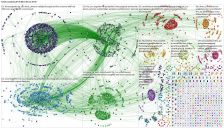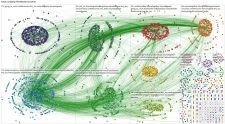This project is currently considering the potential value of an analysis of virtual patterns of trade union organisation and mobilisation and specifically the contribution of social media to the rescaling of trade unionism. This includes both: the virtual linkages of the trade union movement with other forms of social and political activism; and the virtual forms of trade union organisation and mobilisation, which are rooted in specific local sites of mobilisation. In this context we are currently following trade union presence on Twitter in relation to the Trade Union Reform Bill: #TUBill.
The Trade Union Reform Bill and Social media: #TU Bill
The images below are snapshots of Twitter conversations containing the hashtag ‘TUBill’. Each vertex or node in the network is an individual Twitter account (represented in these cases by the user’s profile image). The edges (connections between the vertices), mostly in green, are mentions or retweets. Red edges are fewer in number are represent replies to tweets. This is a typical pattern on Twitter, where mentions and retweets are the most common forms of interaction. The cluster of unconnected vertices in the bottom left corner of the networks are tweets that are not replies, mentions or retweets. The visual characteristics of the networks, such as prominent groupings of vertices, allow quick insight into key moments of the conversation.
On the 28th January 2016, there were 3,085 separate Twitter users captured in the collection, producing 8,465 connections. The clustering patterns in the networks are a result of an algorithm that identifies more densely connected groups of users. In the case of a Twitter conversation such as this, these clusters will typically be the product of a large number of users retweeting something from another user. These users who are frequently retweeted tend to be prominent individuals or organisations such as the TUC, the TUC General Secretary Frances O’Grady, trade unions such as Unite or politicians. The clusters are laid out in their own boxes, which are labelled with a list of most mentioned users in that group. Other centrality metrics can be calculated that quantify indicators of importance in networks such as these, and these are influenced by demographics such as number of followers, or volume of retweets/mentions.
These networks provide us with a picture of how the Twitter conversation around a specific topic changes over time and who is influential in driving this conversation. Such changes can be contextualised by examining, in this case, key moments in the timescale of the Trade Union Reform Bill as it passes through the House of Commons and the House of Lords. In addition, as well as identifying the role played by prominent people and organisations in this area the networks also allow us to see how and when this conversation draws in and impacts on ‘everyday’ Twitter users.



